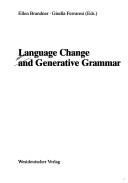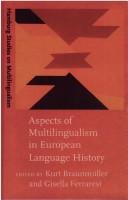| Listing 1 - 10 of 15 | << page >> |
Sort by
|
Book
ISBN: 9783825362980 3825362981 Year: 2014 Volume: 15 Publisher: Heidelberg: Universitätsverlag Winter,
Abstract | Keywords | Export | Availability | Bookmark
 Loading...
Loading...Choose an application
- Reference Manager
- EndNote
- RefWorks (Direct export to RefWorks)
Grammar --- German language --- Allemand (langue) --- Grammaticalisation --- Introductions --- Duits. --- Grammaticalisering. --- Deutsch. --- Einführung. --- Grammatikalisation. --- Introductions.

ISBN: 904291694X 9789042916944 Year: 2005 Volume: 25 Publisher: Leuven: Peeters,
Abstract | Keywords | Export | Availability | Bookmark
 Loading...
Loading...Choose an application
- Reference Manager
- EndNote
- RefWorks (Direct export to RefWorks)
The book aims at providing a precise description of part of the Gothic syntax in the context of a formal theory of syntax. The following questions are addressed: To what extent can Gothic - despite its limited corpus - be used as data material? Further, which of the ascertained syntactic characteristics does Gothic have in common with other old Indo-European languages? Which of these features can be characterized as typically Germanic? It is shown that - despite a certain Greek influence - the Gothic Bible is indeed a rich source of data which can with some certainty be regarded as typically Gothic. Phenomena concerning the left periphery like personal pronouns, topicalization, left-dislocation and discourse particles are described and discussed within the generative framework, with additions from pragmatic and cognitive linguistics for those issues where syntax seems to be inadequate to cover the whole range of the phenomena concerned. The readership aimed at is that of linguists and philologists, and of scholars interested in the interrelation between both disciplines.
Germanic languages --- Grammar --- Gotique (langue) --- Gotisch (taal) --- Syntaxe --- Syntaxis --- Gothic language --- Word order --- Phraseology --- Syntax --- Ordre des mots --- Phraséologie --- Woordvolgorde. --- Gotisch. --- Gotique (Langue) --- Wortstellung. --- Syntax. --- Phraseologie. --- Word order. --- Phraseology. --- Ordre des mots. --- Phraséologie. --- Syntaxe. --- 439.9 --- Language East Germanic Gothic --- Gothic language - Word order --- Gothic language - Phraseology --- Gothic language - Syntax
Book
ISBN: 9783823365587 3823365584 Year: 2011 Volume: 53 Publisher: Tübingen: Narr,
Abstract | Keywords | Export | Availability | Bookmark
 Loading...
Loading...Choose an application
- Reference Manager
- EndNote
- RefWorks (Direct export to RefWorks)
German language --- Ashkenazic German language --- Hochdeutsch --- Judaeo-German language (German) --- Judendeutsch language --- Judeo-German language (German) --- Jüdisch-Deutsch language --- Jüdischdeutsch language --- Germanic languages --- Grammar --- Syntax --- Comparative linguistics --- Grammar. --- Syntax. --- German language - Grammar --- German language - Syntax --- Connecteurs (linguistique) --- Allemand (langue) --- Grammaire comparée --- Syntaxe --- Italien (langue)
Book
ISBN: 3825379795 9783825379797 3825362981 9783825362980 Year: 2014 Publisher: Heidelberg
Abstract | Keywords | Export | Availability | Bookmark
 Loading...
Loading...Choose an application
- Reference Manager
- EndNote
- RefWorks (Direct export to RefWorks)

ISBN: 3531128574 9783531128573 Year: 1996 Volume: 7 Publisher: Opladen: Westdeutscher Verlag,
Abstract | Keywords | Export | Availability | Bookmark
 Loading...
Loading...Choose an application
- Reference Manager
- EndNote
- RefWorks (Direct export to RefWorks)
Historical linguistics --- Grammar --- Changement linguistique. --- Grammaire generative. --- Variation (Linguistique) --- Allemand (Langue) --- Grammaire --- Allemand (Langue) - Grammaire
Book
ISBN: 9783110227468 9783110227475 3110227479 3110227460 1282784080 9786612784088 9781282784086 Year: 2010 Publisher: Berlin New York De Gruyter
Abstract | Keywords | Export | Availability | Bookmark
 Loading...
Loading...Choose an application
- Reference Manager
- EndNote
- RefWorks (Direct export to RefWorks)
In the last few years a lively discussion on information packaging has arisen, where traditional dichotomies Theme/Rheme, Topic/Comment and Focus/Background have been taken up again and partly reinterpreted. The discussion is mainly being held in syntax, but also in the fields of semantics and pragmatics. Some remarkable progress has been made especially in Focus phonology.Even if the role of information conveying and information packaging in the Indoeuropean languages was hinted at as early as in the classical studies of the Neogrammarians, this field has remained neglected in today's historical linguistics. This volume tries to partly cover this lack with a sample of papers which offer a various range of new empirical data analyzed from the point of view of information structure. The novelty of the papers consists in the modern theoretical perspective from which the data are analyzed and in the various phenomena considered, which range from the rise of clitic elements to word order change and verb movement. Editorial board Dr. habil. Kai Alter (Newcastle University Medical School) Prof. Dr. Ulrike Demske (Universität des Saarlandes) Prof. Dr. Ewald Lang (Humboldt-Universität zu Berlin) Prof. Dr. Rosemarie Lühr (Friedrich-Schiller-Universität Jena) Prof. Dr. Thomas Pechmann (Universität Leipzig) Prof. em. Dr. Anita Steube (Universität Leipzig)
Psycholinguistics --- Grammar --- Didactics of languages --- Grammar, Comparative and general --- Language acquisition. --- Language and languages --- Language change. --- Linguistic change. --- Topic and comment. --- Variation. --- Language acquisition --- Linguistic change --- Change, Linguistic --- Language change --- Historical linguistics --- Characterology of speech --- Language diversity --- Language subsystems --- Language variation --- Linguistic diversity --- Variation in language --- Acquisition of language --- Developmental linguistics --- Developmental psycholinguistics --- Language development in children --- Psycholinguistics, Developmental --- Interpersonal communication in children --- Functional sentence perspective (Grammar) --- Predicate and subject (Grammar) --- Subject and predicate (Grammar) --- Theme and rheme --- Topic and comment (Grammar) --- Focus (Linguistics) --- Topic and comment --- Variation --- Acquisition --- Subject and predicate --- Syntax --- Linguistics --- Philology --- Information Structure. --- Language Change.

ISBN: 9027219222 1588114465 9786612160790 1282160796 9027296014 9789027296016 9789027219220 9781588114464 9781282160798 6612160799 Year: 2003 Volume: 2 Publisher: Amsterdam Philadelphia J. Benjamins Pub.
Abstract | Keywords | Export | Availability | Bookmark
 Loading...
Loading...Choose an application
- Reference Manager
- EndNote
- RefWorks (Direct export to RefWorks)
This volume gives an up-to-date account of various situations of language contact and multilingualism in Europe especially from a historical point of view. Its ten contributions present newly collected data from different parts of the continent seen through diverse theoretical perspectives. They show a richness of topics and data that not only reveal numerous historical and sociological facts but also afford considerable insight into possible effects multilingualism and language contact might have on language change. The collection begins its journey through Europe in the British Isles. Then it turns to northern Europe and looks at how multilingualism worked in three towns that are all marked by border and contact situations. The journey continues with linguistic-historical and political-historical visits to Sweden and to Lithuania before the reader is taken to central Europe, where we will deal with the influence of Latin on written German.As far as southern Europe is concerned, the study continues on the Iberian peninsula, where the relationship between Portuguese and Spanish is focused, to be followed by Sardinia and Malta, two islands whose unique geohistorical positions give rise to some consideration of multilingualism in the Mediterranean.
Languages in contact --- Multilingualism --- History. --- Plurilingualism --- Polyglottism --- Language and languages --- Areal linguistics --- History --- Languages & Literatures --- Philology & Linguistics
Book
ISBN: 9789027248183 9027248184 9789027289889 9027289883 1282104527 9781282104525 661210452X 9786612104527 Year: 2008 Volume: 302 Publisher: Amsterdam, NL John Benjamins Pub.
Abstract | Keywords | Export | Availability | Bookmark
 Loading...
Loading...Choose an application
- Reference Manager
- EndNote
- RefWorks (Direct export to RefWorks)
Grammar, Comparative and general --- Reconstruction (Linguistics) --- Syntaxe --- Reconstruction (Linguistique) --- Syntax. --- Syntax --- Internal reconstruction (Linguistics) --- Protolanguages --- Historical linguistics --- Language and languages --- Linguistics --- Philology --- Grammar, Comparative and general - Syntax --- Grammar, Comparative and general Syntax
Book
ISBN: 9783110234350 3110234351 9786613166524 3110252376 1283166526 9783110252378 Year: 2011 Volume: 534 Publisher: Berlin De Gruyter
Abstract | Keywords | Export | Availability | Bookmark
 Loading...
Loading...Choose an application
- Reference Manager
- EndNote
- RefWorks (Direct export to RefWorks)
Das Thema Satzverknüpfung hat sich in den letzten Jahren in der Linguistik als wichtiges Thema für die Beschreibung der Schnittstellen zwischen den verschiedenen Bereichen im Rahmen einer modularen Sprachauffassung etabliert. Der vorliegende Band präsentiert theoretisch und methodisch unterschiedliche Herangehensweisen und unterschiedliche Teilaspekte des Themas. Er versammelt Beiträge aus sprachgeschichtlicher, syntaktischer, diskurssemantischer, lexikalischer und korpuslinguistischer Perspektive und ermöglicht auf diese Weise Einsichten in das Funktionieren des Zusammenhangs zwischen den Ebenen.
Discourse analysis. --- German language --- Grammar, Comparative and general --- Connectives. --- Syntax. --- Historical linguistics. --- Language. --- Linguistics. --- Discourse analysis --- Languages & Literatures --- Philology & Linguistics --- Connectives --- Syntax --- Ashkenazic German language --- Hochdeutsch --- Judaeo-German language (German) --- Judendeutsch language --- Judeo-German language (German) --- Jüdisch-Deutsch language --- Jüdischdeutsch language --- Discourse grammar --- Text grammar --- Connectives (Linguistics) --- Sentence connectors --- Germanic languages --- Semantics --- Semiotics --- Function words --- Discourse markers. --- Sentences. --- Language and languages --- Sentences (Grammar) --- Discourse connectives --- Discourse particles --- Pragmatic markers --- Pragmatic particles --- Pragmatics --- Sentences --- Linguistics --- Philology --- Corpus / Linguistics. --- Discourse Analysis. --- Indo-Europeans / Language. --- Text Coherence. --- Text Linguistics. --- Allemand (langue) --- Syntaxe --- Phrase
Book
ISBN: 9780198813545 0198813546 0192543075 0191851418 9780192543073 Year: 2018 Volume: 28 Publisher: Oxford: Oxford university press,
Abstract | Keywords | Export | Availability | Bookmark
 Loading...
Loading...Choose an application
- Reference Manager
- EndNote
- RefWorks (Direct export to RefWorks)
This volume presents the first comprehensive generative account of the historical syntax of German. Leading scholars in the field survey a range of topics and offer new insights into multiple central aspects of clause structure and word order, including verb placement, adverbial connectives, pronominal syntax, and information-structural factors.
Historical linguistics --- Grammar --- German language --- Syntax --- History --- Grammar, Historical --- Clauses --- Word order --- German language - Syntax - History --- German language - History --- Ashkenazic German language --- Hochdeutsch --- Judaeo-German language (German) --- Judendeutsch language --- Judeo-German language (German) --- Jüdisch-Deutsch language --- Jüdischdeutsch language --- Germanic languages
| Listing 1 - 10 of 15 | << page >> |
Sort by
|

 Search
Search Feedback
Feedback About UniCat
About UniCat  Help
Help News
News